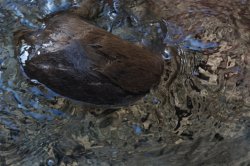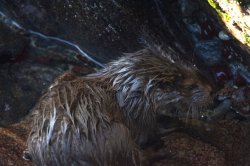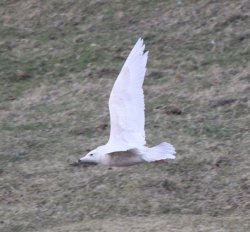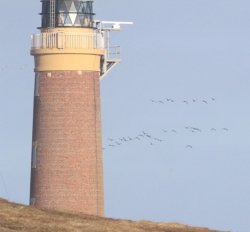A few sightings on North Uist today: an Iceland Gull at Clachan-a-Luib; 16 Whooper Swans flew N at Tigharry (Rene); 24 Snow Buntings at Aird an Runaur (an amazing encounter with two Otter cubs in a deep fissure in rocks at end); only two Pink-footed Geese visible at Sollas (the third from yesterday and the possible Bean Goose probably still present but out of sight in the bumpy ground); the Canada x Barnacle Goose hybrid also still here (first seen on 4th January); a Sparrowhawk was in display flight at Langass.


Tony's Ness news for today: '52 Greenland White-fronted Geese came up the coast from the SE at 08.00 hours, passed over the lighthouse and continued out to sea to NW (wind was SW F5). A 2nd-year Glaucous Gull and a 1st-year Iceland Gull were also present. About 290 Golden Plover were present on the Europie machair in the morning, only two Whooper Swans remained on Loch Stiapavat (20 yesterday) and finally in the evening there were at at least nine Iceland Gulls at their roost on the Port of Ness cliffs.


Also from Tony an intriguing report of a couple of possible Cattle Egrets seen yesterday: 'at 07.15 hours while sea-watching near the Butt of Lewis lighthouse I noticed two white birds heading steadily SE-NW out of The Minch and about a mile out to the east. Conditions were rather murky after Thursdays crystal-clear day and it was difficult to make out any details. I assumed at first they would be Whooper Swans but they were not showing any impression of long necks. Wingbeats were fairly fast and steady and in the misty conditions size was difficult to judge (certainly didn’t look goose or swan size). As they drew level with the tip and still about a mile out the birds turned sharply towards the land. Instead of heading my way, however, they then turned again and resumed their heading back to the SE with scarcely any interruption in their flapping. I watched them until they became fainter and fainter before disappearing from view low to the water.
I’m convinced that they were Cattle Egrets. When I was tour leading in the South Atlantic, I had several occasions when small groups of Cattle Egrets followed the ship at sea for hours on end, with this relentless steady flapping. Some made landings on South Georgia and even Tristan da Cunha, and they are well known for long journeys at sea.
The RBA Weekly Birding Roundup for 15-21 March assessed the total number of Cattle Egrets currently in England, Wales and Ireland to be around 200. There is a photo of a Scottish one perched on a cattle trough at Stranraer (some 300 miles south of the Butt of Lewis). Birdline Scotland were informed and perhaps they will be seen by someone else over the weekend.'


Tony's Ness news for today: '52 Greenland White-fronted Geese came up the coast from the SE at 08.00 hours, passed over the lighthouse and continued out to sea to NW (wind was SW F5). A 2nd-year Glaucous Gull and a 1st-year Iceland Gull were also present. About 290 Golden Plover were present on the Europie machair in the morning, only two Whooper Swans remained on Loch Stiapavat (20 yesterday) and finally in the evening there were at at least nine Iceland Gulls at their roost on the Port of Ness cliffs.


Also from Tony an intriguing report of a couple of possible Cattle Egrets seen yesterday: 'at 07.15 hours while sea-watching near the Butt of Lewis lighthouse I noticed two white birds heading steadily SE-NW out of The Minch and about a mile out to the east. Conditions were rather murky after Thursdays crystal-clear day and it was difficult to make out any details. I assumed at first they would be Whooper Swans but they were not showing any impression of long necks. Wingbeats were fairly fast and steady and in the misty conditions size was difficult to judge (certainly didn’t look goose or swan size). As they drew level with the tip and still about a mile out the birds turned sharply towards the land. Instead of heading my way, however, they then turned again and resumed their heading back to the SE with scarcely any interruption in their flapping. I watched them until they became fainter and fainter before disappearing from view low to the water.
I’m convinced that they were Cattle Egrets. When I was tour leading in the South Atlantic, I had several occasions when small groups of Cattle Egrets followed the ship at sea for hours on end, with this relentless steady flapping. Some made landings on South Georgia and even Tristan da Cunha, and they are well known for long journeys at sea.
The RBA Weekly Birding Roundup for 15-21 March assessed the total number of Cattle Egrets currently in England, Wales and Ireland to be around 200. There is a photo of a Scottish one perched on a cattle trough at Stranraer (some 300 miles south of the Butt of Lewis). Birdline Scotland were informed and perhaps they will be seen by someone else over the weekend.'